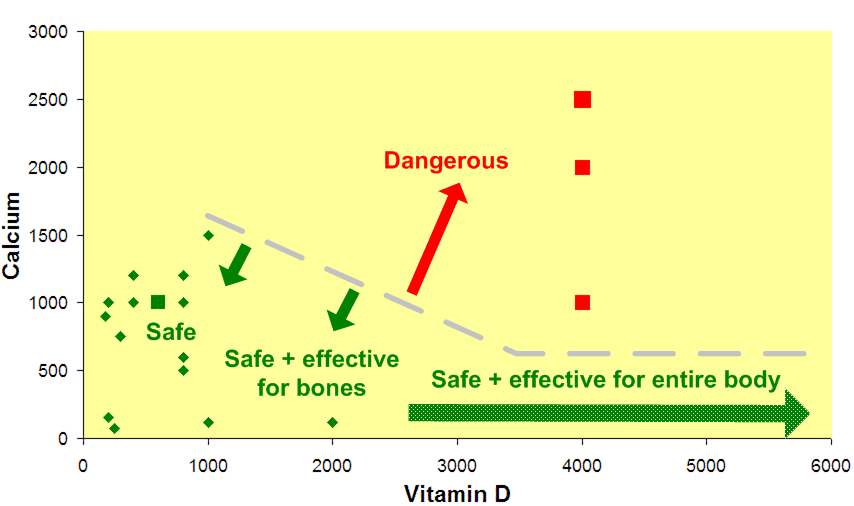Little change in Calcium absorption when taking 400 vs 4,000 IU of vitamin D
The Effect of Vitamin D on Calcium Absorption in Older Women
J. Christopher Gallagher, Vinod Yalamanchili and Lynette M. Smith
Bone Metabolism Unit (J.C.G., V.Y.), Creighton University Medical Center, Omaha, Nebraska 68131; and Department of Public Health (L.M.S.), University of Nebraska Medical Center, Omaha, Nebraska 68198
Address all correspondence and requests for reprints to: Dr. Christopher J. Gallagher, M.D., Creighton University Medical Center, 601 North 30th Street, Suite 6718, Omaha, Nebraska 68131. E-mail: jcg@creighton.edu.
Context: Vitamin D is often recommended for use with calcium supplements to increase absorption.
There are no systematic studies of vitamin D on calcium absorption that indicate what dose should be recommended.
Objective: Our objective was to study the effect of increasing doses of vitamin D3 on calcium absorption.
Design and Setting: We conducted a randomized double-blind placebo-controlled trial at Creighton University Medical Center, Omaha, NE.
Participants: Participants included 163 postmenopausal Caucasian women with vitamin D insufficiency, defined as a serum 25-hydroxyvitamin D (25OHD) below 20 ng/ml (50 nmol/liter).
Intervention: Participants were randomized to receive one of the vitamin D3 doses, 400, 800, 1600, 2400, 3200, 4000, or 4800 IU/d, or placebo for 1 yr.
Calcium intake was increased to 1200–1400 mg daily by giving daily calcium citrate.
Main Outcome: We evaluated the change in calcium absorption on vitamin D.
Results: Mean serum 25OHD increased from baseline 15.6 ng/ml (39 nmol/liter) to 46.5 ng/ml (112 nmol/liter) in subjects randomized to the highest dose of vitamin D (4800 IU). Calcium absorption was more significantly related to serum 25OHD (R2 = 0.50; P = 0.001) than dose (R2 = 0.47; P = 0.033). Calcium absorption of a 100-mg dose increased from 52–58% (6 mg) over a serum 25OHD range of 20–66 ng/ml (50–165 nmol/liter).
Conclusions: There was no evidence of a threshold for reduced calcium absorption in the serum 25OHD range of 10–66 ng/ml (25–165 nmol/liter).
The increase in absorbed calcium of 6% on high doses of vitamin D is so small that the same amount could be obtained from half a glass of milk (100 ml) or 100 mg elemental calcium.
The results challenge assumptions about the value of adding vitamin D to increase calcium absorption except when serum 25OHD is very low that is less than 10 ng/ml (25 nmol/liter).
Received April 20, 2012, Accepted July 5, 2012, Copyright © 2012 by The Endocrine Society
This does indeed challenge assumptions , but it is not the first one to do so.
See also VitaminDWiki
Calcium bioavailability and how much to take which has the following graph

More Calcium absorbed with more vitamin D – 6.7% more with 4000 IU – RCT March 2014
Controversy: Too much Calcium if increase Vitamin D
- some say major problem with just 2,000 IU of vitamin D, others say no problem with 10,000 IU
Calcium intestinal absorption increased with active, but not tested level of vitamin D – May 2014
Calcium absorption increased only 6 % for high amounts of vitamin D – RCT Aug 2012 conflicts with previous understanding
Must balance co-factors when increasing vitamin D 500 Ca, 500 Mg - which has the following concept graph

